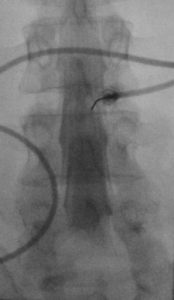What is a Myelogram Test?
 A Myelogram test is a test in which radiographic dye is inserted via a needle into the patient’s spinal canal, and then x-rays or CAT scans are obtained.
A Myelogram test is a test in which radiographic dye is inserted via a needle into the patient’s spinal canal, and then x-rays or CAT scans are obtained.
Myelograms are typically recommended for the following symptoms or conditions:
- When the source of chronic back or neck pain is not clear from other diagnostic tests such as MRI or CT scans.
- To evaluate causes of spinal cord compression such as tumors, herniated discs, or spinal stenosis.
- To assess spinal infections or inflammatory diseases like arachnoiditis.
- For detailed images of spinal lesions or congenital anomalies.
- To assess the spine after surgery, especially when metal implants hinder other imaging tests.
- For nerve root disorders, such as sciatica, to determine if nerve roots are being compressed.
- When symptoms like numbness, weakness, or bladder and bowel dysfunction suggest a spinal problem.
It’s important to note that a myelogram is often used when other tests haven’t provided enough information, or in specific situations where detailed images of the spinal cord and surrounding structures are necessary.
The decision to have a myelogram is made by a healthcare provider based on an individual patient’s symptoms and medical history.
Are there any side effects from having this type of test?
There are potential side effects. They can include headaches, nausea, or dizziness. These side effects are usually temporary and often resolve on their own or with simple treatments like over-the-counter pain relievers.
For a short period of time after a myelogram, patients might be advised to avoid activities that can increase pressure in the head, like flying in an airplane or lifting heavy objects.
It’s essential to follow a provider’s specific instructions after a myelogram. Again, this is because recommendations can vary based on individual health factors and the specifics of the procedure.
